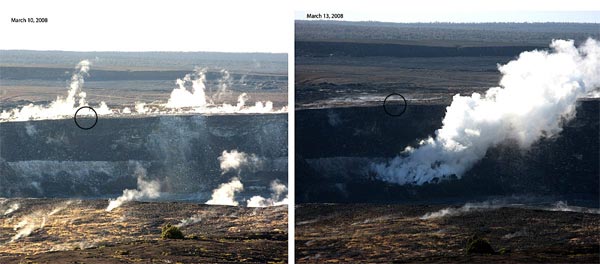USGS HVO News Release
March 14, 2008

Views of the east wall of Halema`uma`u crater on March 10 and 13, 2008, showing the emergence of a new gas vent. The Halema`uma`u crater overlook is circled. Note the large gas plume in the right frame taken on March 13, 2008.
|
A prominent new gas vent broke through the lower east wall of Halema‘uma‘u this week, doubling the already elevated level of sulfur dioxide gas being emitted from the crater.
The rate at which sulfur dioxide (SO2) is released by Kilauea volcano has typically been 150-200 tonnes/day, but in late December 2007, the emission rate increased to nearly 300 tonnes/day. This rate continued to rise into the new year, and by mid-February 2008, it fluctuated between 600 and 1000 tonnes/day.
On March 12, the rate abruptly jumped to 1,500 tonnes/day. The following day, SO2 emission rates reached the highest recorded at Kilauea’s summit since measurements began in 1979—from 1,800 to 2,000 tonnes/day.
With increased emission rates, the concentration of noxious sulfur dioxide gas in the air, the cause of respiratory hazards, also rises. When the emission rate doubled in December 2007, sulfur dioxide concentrations exceeded 1 ppm on more than half of Crater Rim Drive between the Southwest Rift Zone pullout and the Halema‘uma‘u Overlook parking lot. The increased SO2 concentration and associated incidents of respiratory distress in visitors prompted the National Park Service to restrict access to roads and trails around Kilauea Caldera.
After the new gas vent opened this week, sulfur dioxide concentrations exceeded 40 ppm along Crater Rim Drive, significantly increasing respiratory hazards downwind of the vent.
Sulfur dioxide gas reacts with air, moisture, and sunlight to form tiny acidic particles that are readily retained in human lungs. Thus, it is listed by EPA as one of six criteria air pollutants. Factories, power plants, and other industrial sources are required to regulate their output of SO2 to prevent possible negative effects on human health and the environment. Elevated SO2 levels can cause breathing difficulties, especially in people with preexisting respiratory problems, irritation of the eyes, nose, and throat, and damage to plants and water. For more information on the effects of volcanic gases, check with the International Volcanic Health Hazard Network at http://ivhhn.org/.
Release of sulfur dioxide gas from Kilauea volcano is not new, but the current emission rates are unusual. Gas emissions have been unsettled since June 2007, the beginning of the current Father’s Day eruptive activity, but the root cause of the recent increase in SO2 emissions from Halema‘uma‘u crater is not yet clear.
While it is a remote possibility, a summit eruption is not expected because other harbingers of summit activity have not occurred. We continue to monitor for signs such as inflation and increased earthquake activity at Kilauea summit.
***USGS***
USGS provides science for a changing world. For more information, visit www.usgs.gov.
Subscribe to USGS News Releases via our electronic mailing list (http://www.usgs.gov/newsroom/list_server.asp) or RSS (http://www.usgs.gov/newsroom/default.asp) feed.
USGS provides science for a changing world. For more information, visit http://www.usgs.gov.
|

